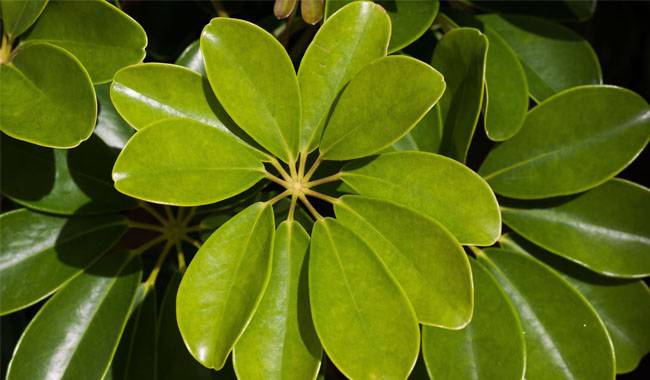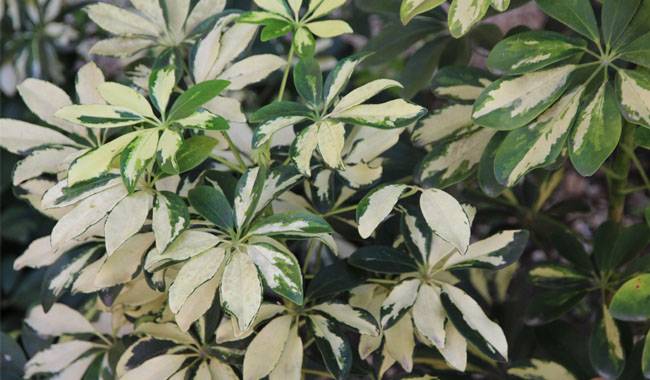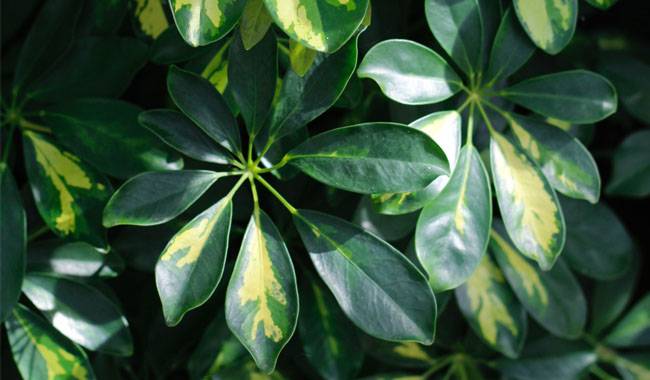
For example, it isn’t easy to find a plant as colorful as Schefflera among the giants in the room. And again, there are no requirements. Schefflera are members of the Araliaceae family and are pretty easy-going. They are not demanding and can easily cope with poor care, but are afraid of wet conditions. As a result, schefflera has a colorful and unusual appearance. Dazzling, often colorful umbrella-like leaves, relentless growth, flexible shapes, and the ability to adapt to any environment – this plant has a lot going for it. It’s no wonder there are a growing number of fans of Schefflera. You will learn how to grow Schefflera plants in ThumbGarden’s article.
SCHEFFLERA PLANT DESCRIPTION
Lush, rather large, bushy, or tree-like, depending on species and formation, room shampoo can reach a height of 80 inches (2 m), but with proper care is most often limited to 40-60 inches (1-1.5 m). Schefflera grows rather slowly. Today, in addition to the traditional form, Schefflera is very popular in the shape of a bonsai.
When young, the shoots seem too thin for the huge foliage, and as they age, they become woody, bare, and elongated, but the “umbrella tree” effect is always maintained.
There is a reason Schefflera’s leaves are not called palmate or umbrella-shaped. With their complex lobes, they are surprised to find eight to twelve long oval, neatly arranged umbrella-like lobes up to 6 inches (15 cm) long and up to 2 inches (5 cm) wide. The leathery texture is combined with a glossy surface and a matte, light-colored underside. The petiole is very long and perfectly straight. The color depends on the species and cultivar and is either dark and rich or bright and variegated with irregular spots.
Despite the beauty of the greenish-white inflorescence branches, it cannot be appreciated at home. It is a poisonous plant: its sap is irritating to both mucous membranes and skin.
SPECIES OF INDOOR SCHEFFLERA PLANT
Schefflera arboricola is a compact species, 30-47 inches (0.8-1.2 m) long, with woody shoots that can be easily shaped by pruning. The dark foliage with smooth, inverted, teardrop-shaped lobes looks magnificent. There are many clumped forms and varieties with yellow, cream, and white spots on the leaves.
Schefflera actinophylla is a large, fast-growing species with seven leaves and light green color, nicknamed “octopus tree.”
Schefflera digitata is a large, dark-leaved species with wavy lobes and sharp margins.
Schefflera heptaphylla is an exciting species with pendulous leaves, lanceolate lobes with light-colored veins, and a color change from olive to dark green.
Schefflera elegantissima is a special heat- and moisture-loving species of Schefflera that formerly belonged to the Disigotheca species. The narrow, toothed, palmately divided leaves and slender shoots up to 60 inches (1.5 m) long look airy and picturesque.
GROWING CONDITIONS FOR INDOOR SCHEFFLERA PLANTS

The main thing is to control the light and not to change the growing conditions too much. Otherwise, it is very comfortable in the living room.
Lighting and placement
Schefflera plants have light but do not like sunlight. Therefore, they can avoid direct light. Light shade is acceptable for non-flame varieties, but bright diffused light is still best. Without adequate light, Schefflera flowers will stretch, overhang, and deform. Indoors, plants are placed close to windows. The ideal lighting is similar to that of eastern and western windowsills.
From mid-autumn, lighting needs to be adjusted to maintain the usual regime. Schefflera flowers can be moved to a brighter location or arranged for additional light. Schefflera requires a lot of space and is best placed separately from other plants. Do not move pots close to walls. Schefflera needs to be rotated regularly for even development.
Temperature and ventilation
A steady heat of 68 °F (20°C) from spring to fall is suitable for Schefflera. The optimum range for overwintering is 59-64 °F (15-18 °C). Some variegated varieties require overwintering temperatures of 64-68 °F (18-20°C) – check this when buying plants. Schefflera drops its leaves at temperatures below 53 °F (12°C) and does not like high temperatures.
Schefflera does not tolerate drafts and temperature differences, even in mild forms, in either winter or summer. Therefore, it is brought into fresh air only in summer, in protected semi-mountainous areas, emphasizing nighttime temperatures above 57 °F (14 °C).
CARING FOR SCHEFFLERA PLANT AT HOME
Careful watering is the basis for proper Schefflera care. Since it does not require frequent watering, it is suitable even for frequent travelers.
Watering and air humidity
Even in summer, Schefflera is afraid of overwatering, and a slight drought is easier to tolerate than a short humidity period. Water moderately, immediately draining any water released into the tray and allowing the soil to dry 1-2 inches (2.5-5 cm) to maintain a steady but light moisture level. Once daylight hours are over, you can reduce watering by cutting half the amount and frequency of watering. Typically, watering once a week in summer and twice a week in winter is sufficient for Schefflera. Schefflera readily adapts to the dry air in apartments, although 60-75% humidity is considered ideal. They like to be sprayed, especially in winter. The plants should be wiped regularly with a damp sponge to remove dust from the leaves.
Feeding and fertilizer composition
Schefflera plants can be fertilized all year round, even in winter, just at different frequencies. Fertilizer is applied every 2 weeks at half the usual rate in summer and every 5-6 weeks in winter.
Only fertilizers that contain both macro and micronutrients (multi-purpose fertilizers) are suitable for Schefflera plants.
Pruning and shaping Schefflera plants
Plants can be shaped as needed, but Schefflera also grows well free. Damaged, dry, and poorly shaped shoots should always be pruned. It is best to choose squat varieties or grow several plants per pot for lush growth forms, but you can also try to stimulate growth by shortening the tips. Only strong enough pruning, through 5-6 internodes or more, will stimulate the release of lateral branches. Tie up the stems if desired.
The best time to cut off Schefflera is before it starts to grow vigorously, i.e., in March. Thin shoots often need to be tied to a stand. Older and severely damaged plants can be rejuvenated by extensive stump pruning.
Repotting, Containers and Substrates
Report Schefflera only when truly necessary. Containers can be replaced throughout the first half of the active growth phase. Renew the topsoil twice a year.
Use a nutrient-rich, versatile, well-ventilated substrate with a loosening agent (perlite, charcoal soil, vermiculite). Special substrates for palm trees or roses are good. The container should be large, not too high, increasing in size by about 2 inches (5 cm).
Schefflera should be transplanted carefully, keeping the root ball as small as possible. A high drainage layer of 2 inches (5 cm) or more) is mandatory.
Schefflera plants grow well in hydroponics.

PESTS AND PROBLEMS IN GROWING SCHEFFLERA
In high temperatures and low humidity, this plant is not susceptible to insect pests if not properly cared for. Thrips, scale mites, and spider mites can spread very quickly, attacking the leaves and the shoots, and are usually visible to the naked eye. At first suspicion, the plant should be isolated and treated with an insecticide (such as a biosimilar).
Excessive watering and waterlogging can quickly lead to root and shoot rot, especially in the fall and winter. If there is also excessive cold, Schefflera will develop spots. Schefflera can be saved by prompt corrective care, drying the soil, and watering with a fungicide solution. Emergency transplanting is an extreme and often fatal measure.
Schefflera can easily defoliate in cold, heat, and over-watering conditions. The latter is indicated by the plant itself – through air bubbles on the back of the leaves. Schefflera flowers tend to become misshapen, discolored, yellowed, and wilted if they are excessively dry, overheated, and lack light.
PROPAGATION OF SCHEFFLERA
Self-propagation of Schefflera offspring requires patience. The easiest way is to take cuttings. In Schefflera, root tip and stem cuttings are taken from non-woody shoots by immersing them under a hood in a light, breathable or inert substrate with controlled soil and air moisture stability. Bottom heating is desirable. Rooting takes several months, and young plants should be handled with great care.
Schefflera can also be rooted by cutting shoots vertically and wrapping them in moist moss, aluminum foil, or film to form a root system.
Seeds are less common because they do not retain the characteristics of the species. Seeds are sown in spring or summer under glass or aluminum foil at a constant temperature of 68-77 °F (20-25 °C) with the aid of a bottom heater.







